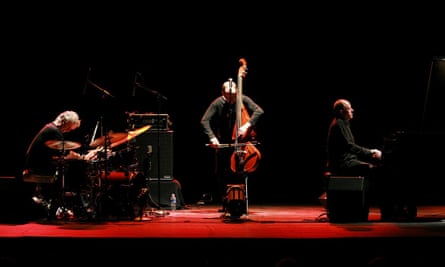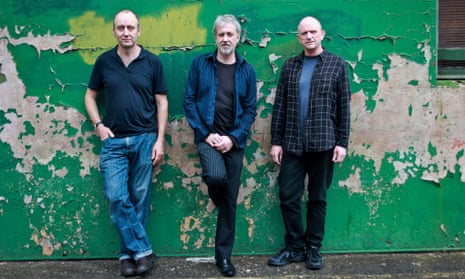The Necks are about to record a new album. It will be the Australian improv trio’s 18th, and as is customary, not even the band members know what it will sound like. “I guess we’ll be talking about it when we get in the studio,” says drummer Tony Buck with a laugh.
Part way through a seven-date Australian tour, he isn’t sharing any insights into the follow-up to their languorous, single-track 2013 LP Open, mainly because he can’t. The band – whose other members include pianist Chris Abrahams and double bassist Lloyd Swanton – don’t discuss their music before they make it.
“In general we’ve never had very much to say,” Buck says. “Twenty-nine years ago we talked about what we’d like to explore in this kind of music-making and what it might give us that other projects weren’t fulfilling. Then we got down to playing and finding ways to do it and we haven’t really talked much about it since.”
This quiet practice might be familiar collateral to the emotionally tamped Australian male (and perhaps in league with the band’s sixth album – the soundtrack to the grim 1998 suburban drama, The Boys). But the approach provides fuel. Famously, the band arrive on stage with no preconceived idea of what is about to be played.
Formed in Sydney in 1987, the Necks took shape as an outlet free from the relative confines of jazz. Playing at parties, in pubs and, before long, rock clubs, the formally trained musicians teased out a musical language that required them to submit to the unknown. Now recognised internationally for their hallucinatory, immersive soundscapes (or as Swanton recently told ABC radio, “clouds of sound and shimmering textures that pass each other”), Buck says the Necks as they started out had to set aside everything they knew.
“Some of the music we first played was about being exciting, or pushing energy or showing people how clever we were. But we were like, ‘let’s take that out of the equation. Let’s not force anything and just chill. Let the music unfold at its own pace’.” And when they did, the sound grew.

“We used to lock into a kind of traditional way of playing music with piano, bass and drums,” Buck explains. “The thing that wasn’t traditional is that we didn’t really stick on things for a long period of time. We’d explore the way the instruments blended and how playing something for a longer duration changes it.”
While this still happens, says Buck, the trio are also finding more intricate ways of making these connections. “We’re playing different tempos and different harmonic areas, but it still has this cyclic durational and tamboral blend thing. It’s more abstract and becomes even more psychoacoustic and psychedelic. It gives the things that we’ve always been doing more depth.”
Watching the band live is a mystery. As the shut-eyed musicians explore their instruments, entire passages arrive and depart unannounced, as if new sounds are being piped in over the loudspeaker or played by an unseen hand. Time stalls and stretches, and the intensity of incremental moments – Swanton trading pizzicato for arco; Abrahams exploring a single note – gets noticed and lost again in an unspooling tapestry of sound.
Sets can run to two or three hours. “If you’re in the middle of it you can have a very different impression of what’s happening than if you’re on the outside looking in,” says Buck. “I’ve played and thought: ‘Well this sounds weird. It’s not really working.’ And then I’ve listened back to a recording and it’s really interesting.”
Relying so heavily on the ability to conjure something from nothing must seed doubt. “Sometimes there are sections where it feels like we aren’t creating a unified front,” says Buck. “But one thing we’ve learned over the years is given time, these things find their own balance. Maybe indirectly you don’t even know what you’ve changed, but you find you adjust to the gravity of the music.”
While the band have harnessed a sort of musical telepathy, they have yet to resolve their curiosity. “You develop a bigger vocabulary and more reference points until those reference points become irrelevant because there’s so many of them,” says Buck. “That’s the aim as a musician, especially an improvisational musician – to become free. You increase your vocabulary to the point where you don’t ever have to consider your vocabulary.”
Despite the concert halls, accolades and growing heft of the Necks’ legacy, that vocabulary remains utilitarian. One YouTube commenter writes under a clip of the band’s 2003 album, Drive By: “It helps me to relax when I don’t feel good while grinding poker.” Buck translates the note via a particularly Australian aphorism: “On one level you can analyse it – we all know what we’re doing and if someone asks us what we’re specifically, we could talk about it. But it’s really simple. Just play. Don’t push it. And don’t worry.”

Comments (…)
Sign in or create your Guardian account to join the discussion